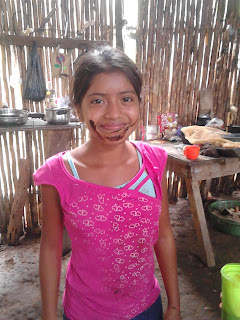I (Katerina) have been dreaming of this project ever since August, when Marta and I went on a
chocolate-making tour with a local Mayan family in Lanquin. As some of you may already know,
the cacao bean grows marvellously in the tropics of Central America and the chocolate drink is
native to the precolumbian Maya culture of Mesoamerica. And indeed, its heritage is long-lasting:
every Maya family in the village, and most probably in the region, knows how to make delicious
hot chocolate out of the cacao pods that grow by the dozen in their home gardens. However, the
strangest of all is that good quality dark chocolate that fills up the supermarket shelves back in
Europe (Lindtt, Nestlé, Cote d'Or, etc.) is almost impossible to find in Guatemalan supermarkets or markets, especially in rural areas (like Teleman).
We have been pondering over this paradox for quite some time now: how can one of the top cacao producers in the world lack locally produced good quality chocolate bars? If we can't solve the
riddle on a national level (our guess is that all cacao goes out for export to Occidental countries, and
there is no processing industries in Guatemala), we can at least try to do something on a local level.
This was the initial inspiration behind the chocolate-making workshop aiming to teach the
community how to prepare artisanal chocolate bars and sweets “from scratch“, using raw cacao
beans, in home conditions.
Our first trial session was in the 2nd week of November. And I have to say, considering the lack of
(professional) equipment at our limited resources, it probably went as well as it could have! The 15
participants we had spanned all age categories and came from all over the village: young children,
basico students, the owner of the local shop, and a couple of mothers who came with their
children, curious to see the action.
We were very lucky to receive the support of a local woman, Angela, who welcomed us in
her house and lent us her tools without which the chocolate-making would have been impossible.
The most important of these, of course, are the comal (a sort of large toasting pan typical in Maya
culture) and her manual mill (actually, a simple meat-grinder). The overarching idea behind the
workshop was to combine the traditional chocolate-making art of the Mayas and modern
techniques to perfection the process and turn an ancestral drink into a solid chocolate-bar. For this
reason, we insisted on following the traditional cooking process and using the traditional tools
(such as the comal) as much as possible. Also, the presence in itself of a local woman who has been
preparing chocolate for as long as she can remember is, of course, invaluable!
The recipe we followed was as simple as can be: toasting the cacao beans on the comal for half an
hour until they “cracked” and popped, grinding them in the mill, adding cinnamon, milk, sugar and
vanilla to give it the initial form. The consistency appeared to be perfect: liquid enough to pour
into the ice-trays that we used as moulds, and to turn solid there.
The amount of participants also turned out to be very appropriate: not too many to create
unnecessary hassle, but not too few either. Each one of them had a specific task to do and was
happy to concentrate on it. Shelling the peanuts, cutting the raisins, getting the vanilla dust out of
the vanilla pods, toasting, grinding the cacao beans, adding milk, sugar, mixing… and so on!
As this was our first session, a bit of experimentation by the “trial and error” method was
inevitable! The fun part was to do in the most democratic way possible: everyone was allowed to
dip their spoon in the chocolate mass in the bowl and was asked their opinion: too bitter? Too
sweet? Do we add more milk? Can you taste the vanilla and the cinnamon?
And a dozen of overexcited voices filled the room, each one giving a different advice!..
Let's be fair on ourselves: the chocolate that we ended up carrying home to freeze for a few days in
our refrigerator, after decorating it with raisins and peanuts, had a rather rough and sandy texture.
It left a bitter aftertaste, despite the copious amounts of sugar that we put in, and most
disappointing of all – it melted within the five minutes after we took it out of the freezer to share
with the children the following week!
Well, disappointing for us, maybe, but not for the children! They were just as delighted to receive a
liquid version of the fruit that we achieved with the help of their labour, and they always came
back for a second and third round. In the end, even if we are not entirely satisfied with the final
product, the participants' joy is what really matters.
And next time, well refine the recipe and consult professional sources to try and figure out how we
could improve our chocolate to make it as mouthwatering as the one that Roal Dahl describes in
Charlie's adventures at Willy Wonka's famous factory!
Written by: Katerina






No comments:
Post a Comment